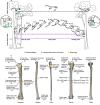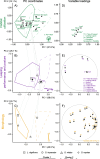Linking morphology, performance, and habitat utilization: adaptation across biologically relevant 'levels' in tamarins
- PMID: 38355429
- PMCID: PMC10865561
- DOI: 10.1186/s12862-023-02193-z
Linking morphology, performance, and habitat utilization: adaptation across biologically relevant 'levels' in tamarins
Abstract
Background: Biological adaptation manifests itself at the interface of different biologically relevant 'levels', such as ecology, performance, and morphology. Integrated studies at this interface are scarce due to practical difficulties in study design. We present a multilevel analysis, in which we combine evidence from habitat utilization, leaping performance and limb bone morphology of four species of tamarins to elucidate correlations between these 'levels'.
Results: We conducted studies of leaping behavior in the field and in a naturalistic park and found significant differences in support use and leaping performance. Leontocebus nigrifrons leaps primarily on vertical, inflexible supports, with vertical body postures, and covers greater leaping distances on average. In contrast, Saguinus midas and S. imperator use vertical and horizontal supports for leaping with a relatively similar frequency. S. mystax is similar to S. midas and S. imperator in the use of supports, but covers greater leaping distances on average, which are nevertheless shorter than those of L. nigrifrons. We assumed these differences to be reflected in the locomotor morphology, too, and compared various morphological features of the long bones of the limbs. According to our performance and habitat utilization data, we expected the long bone morphology of L. nigrifrons to reflect the largest potential for joint torque generation and stress resistance, because we assume longer leaps on vertical supports to exert larger forces on the bones. For S. mystax, based on our performance data, we expected the potential for torque generation to be intermediate between L. nigrifrons and the other two Saguinus species. Surprisingly, we found S. midas and S. imperator having relatively more robust morphological structures as well as relatively larger muscle in-levers, and thus appearing better adapted to the stresses involved in leaping than the other two.
Conclusion: This study demonstrates the complex ways in which behavioral and morphological 'levels' map onto each other, cautioning against oversimplification of ecological profiles when using large interspecific eco-morphological studies to make adaptive evolutionary inferences.
Keywords: Biomechanics; Field study; Integrative biology; Leaping behavior; Limb bones; Locomotion.
© 2024. The Author(s).
Conflict of interest statement
The authors declare no competing interests.
Figures




Similar articles
-
Vertical clinging and leaping induced evolutionary rate shifts in postcranial evolution of tamarins and marmosets (Primates, Callitrichidae).BMC Ecol Evol. 2021 Jun 25;21(1):132. doi: 10.1186/s12862-021-01848-z. BMC Ecol Evol. 2021. PMID: 34171986 Free PMC article.
-
Phylogenetics and an updated taxonomic status of the Tamarins (Callitrichinae, Cebidae).Mol Phylogenet Evol. 2022 Aug;173:107504. doi: 10.1016/j.ympev.2022.107504. Epub 2022 May 14. Mol Phylogenet Evol. 2022. PMID: 35577298
-
Patterns of positional behavior in mixed-species troops of Callimico goeldii, Saguinus labiatus, and Saguinus fuscicollis in northwestern Brazil.Am J Primatol. 2001 May;54(1):17-31. doi: 10.1002/ajp.1009. Am J Primatol. 2001. PMID: 11329165
-
Leaping behavior of Pithecia pithecia and Chiropotes satanas in eastern Venezuela.Am J Primatol. 2005 Aug;66(4):369-87. doi: 10.1002/ajp.20162. Am J Primatol. 2005. PMID: 16104032
-
Forest use and activity patterns of Callimico goeldii in comparison to two sympatric tamarins, Saguinus fuscicollis and Saguinus labiatus.Am J Phys Anthropol. 2004 Jun;124(2):139-53. doi: 10.1002/ajpa.10343. Am J Phys Anthropol. 2004. PMID: 15160367
References
-
- Bock WJ, Von Wahlert G. Adaptation and the form-function complex. Evolution. 1965;269–99. 10.2307/2406439.
-
- Garber PA. Primate Locomotion. Boston, MA: Springer; 1998. Within-and between-site variability in moustached tamarin (Saguinus mystax) positional behavior during food procurement; pp. 61–78.
-
- Reilly SM, Wainwright PC. Conclusion: ecological morphology and the power of integration. In: Wainwright PC, Reilly SM, editors. Ecological Morphology: Integrative Organismal Biology. Chicago: University of Chicago Press; 1994. pp. 339–54.
MeSH terms
Grants and funding
LinkOut - more resources
Full Text Sources
